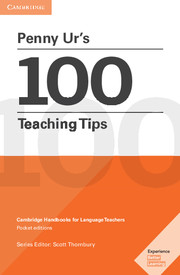Book contents
- Frontmatter
- Contents
- Why I Wrote this Book
- Beginning and Ending the Lesson
- The Coursebook
- Discipline
- Error Correction
- Games
- Grammar
- Group Work
- Heterogeneous (Mixed-Level) Classes
- Homework
- Interest
- Listening
- Pronunciation
- Reading Comprehension
- Speaking Activities
- Teacher Talk
- Testing and Assessment
- Vocabulary Teaching
- Writing
- P.S.
- Index
- Photo Acknowledgements
Reading Comprehension
Published online by Cambridge University Press: 17 November 2023
- Frontmatter
- Contents
- Why I Wrote this Book
- Beginning and Ending the Lesson
- The Coursebook
- Discipline
- Error Correction
- Games
- Grammar
- Group Work
- Heterogeneous (Mixed-Level) Classes
- Homework
- Interest
- Listening
- Pronunciation
- Reading Comprehension
- Speaking Activities
- Teacher Talk
- Testing and Assessment
- Vocabulary Teaching
- Writing
- P.S.
- Index
- Photo Acknowledgements
Summary
The reading text is normally the first and most important component of a textbook unit and the basis for later language work. So it's worth investing some thought into how to make it accessible and learning-rich.
66 Read aloud while students follow
67 Minimize guessing from context
68 Don't make students read aloud
69 Read and re-read
70 Use readers’ theatre
71 Vary comprehension tasks
66 Read aloud while students follow
It can be very difficult for students to try to cope with a new text on their own. It's made a lot easier if the teacher reads aloud while they read along.
The reading text, which is normally a prominent feature of any course unit, is usually studied intensively and ‘milked’ for vocabulary and grammar. But because a lot of this language is new, the texts are likely to be relatively difficult for the students. We need, therefore, to think about how to support their understanding of the content. Pre-teaching some of the vocabulary can help to some extent, though possibly not as much as we might expect (see Tip 57). But perhaps the most learnerfriendly and effective way of mediating a new text is to read it aloud while students follow. There's some research to confirm this (see the reference below).
When you read the text, you intuitively use appropriate prosody: group the words into sense-patterns, insert pauses in the right places, and add appropriate intonation. This is what clarifies meaning. In addition, it's easy to stop every now and again to explain new words as you feel necessary. And you can keep an eye on your students, pick up any expressions of incomprehension and respond as necessary.
But you do have to make sure that they are in fact following the text! I find that when I read aloud some of them tend to raise their eyes, look at me, and abandon the reading completely. The exercise becomes a kind of listening comprehension – which defeats the purpose! You need to keep glancing at your students, make sure they are reading, and move to help ones who have lost their place.
67 Minimize guessing from context
Guessing from context is a reading strategy encouraged by many methodologists; but actually it's surprisingly unreliable as a way of accessing word meaning.
- Type
- Chapter
- Information
- Penny Ur's 100 Teaching TipsCambridge Handbooks for Language Teachers, pp. 78 - 84Publisher: Cambridge University PressPrint publication year: 2016



